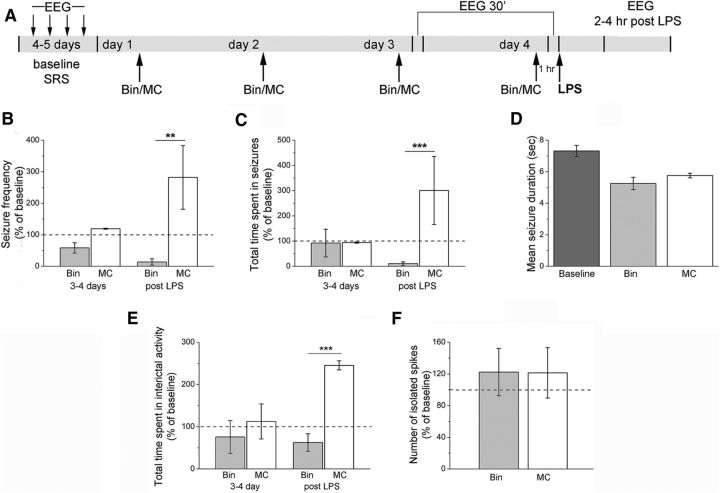Figure 7.
Treatment with bindarit abolishes the seizure-enhancing effect of LPS. A, Experimental protocol. After baseline assessment of SRS, animals were treated daily with either bindarit (Bin) or vehicle (MC) and injected systemically with LPS on the fourth day. B, C, Frequency of seizures and total time spent in ictal activity per 10 min of recording (normalized to the baseline period). Before LPS treatment (3–4 d), seizure frequency and total time spent in seizures were unaltered by either bindarit or vehicle with respect to baseline (two-way repeated-measures ANOVA followed by Holm–Sidak test, p > 0.05). After LPS challenge (post LPS), seizure frequency and total duration of ictal activity were significantly higher in controls with respect to bindarit-treated animals (p < 0.01). D, Mean seizure duration in bindarit (Bin) and control animals (MC) before (baseline) and after LPS administration. Mean seizure duration was unaffected by LPS + bindarit or LPS + MC treatment (one-way ANOVA, p = 0.7). E, Total time spent in interictal activity per 10 min of recordings (normalized to the baseline period). Before LPS treatment (3–4 d), total time spent in interictal activity was unaltered by either bindarit or vehicle with respect to baseline (two-way repeated-measures ANOVA, p > 0.05). After LPS (2–4 h after treatment), the total duration of interictal activity was significantly higher in controls with respect to bindarit-treated animals (two-way repeated-measures ANOVA, p < 0.001). F, Number of isolated spikes per 10 min of recording (normalized to the baseline period). Bindarit- and vehicle-treated epileptic mice showed the same range of isolated spike frequency 2–4 h after LPS administration (two-way repeated-measures ANOVA followed by Holm–Sidak test, p = 0.3). **p <0.01; ***p < 0.001.

